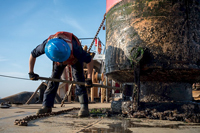 The craftsman’s motto, “measure twice, cut once” is a sort of microcosm of everything you need to know in order to bring projects in on time and under budget. Cutting corners, taking shortcuts, neglecting necessary expenses, that might help you save time and money in the short run, but best case scenario, it’s going to wind up costing you more in labor and budget to redo it later on. Worst case scenario, you build a faulty home that collapses in the first year, if it manages to pass inspection in the first place, and then nobody ever hires you again.
The craftsman’s motto, “measure twice, cut once” is a sort of microcosm of everything you need to know in order to bring projects in on time and under budget. Cutting corners, taking shortcuts, neglecting necessary expenses, that might help you save time and money in the short run, but best case scenario, it’s going to wind up costing you more in labor and budget to redo it later on. Worst case scenario, you build a faulty home that collapses in the first year, if it manages to pass inspection in the first place, and then nobody ever hires you again.
The first thing to go when people take shortcuts tends to be safety. A rush job makes for an unsafe work environment, and results in an unsafe living environment. No matter how much time and money you save on the job, it’s no good if you wind up paying it back in legal fees and time spent in the court room.
So how do you save time and money without taking dangerous shortcuts?
- Be Pragmatic When Buying Tools And Materials
Simply put: there’s not much that a $200 hammer can do that a $10 hammer cannot. Don’t cut costs on quality, but shop around, and don’t overspend on fancy tools and materials that you don’t need.
- Overestimate All Costs
If you promise your client that you’ll have the addition done in a week, and then a nasty thunderstorm hits on day seven, you’re going to wind up trying to finish up the roof in the middle of a heavy downpour. Promise a two week turnaround on the same project, and the client will be delighted to see the project finished six days early. Don’t make “best case scenario” promises. As they say, plan for the worst, hope for the best.
- Pay A Little More For Experience When You Need To
A $12-a-hour lackey might be able to install a kitchen sink if you give him the whole weekend to do it. A $30-an-hour professional plumber might be able to get the same sink installed in an afternoon. Saving money often means spending a little more now so you can spend considerably less in the long run.
- Don’t Overcommit Yourself
You’re going to burn through a lot of gas and a lot of daylight if you’re running three jobs at a time and driving all over town to get to them. If client #2 can’t wait a few days for you to finish up a job for client #1, they’re probably a pain in the neck to do business with anyways.
It all comes down to common sense, really: Pace yourself, set realistic goals, spend wisely, and always put safety first.














